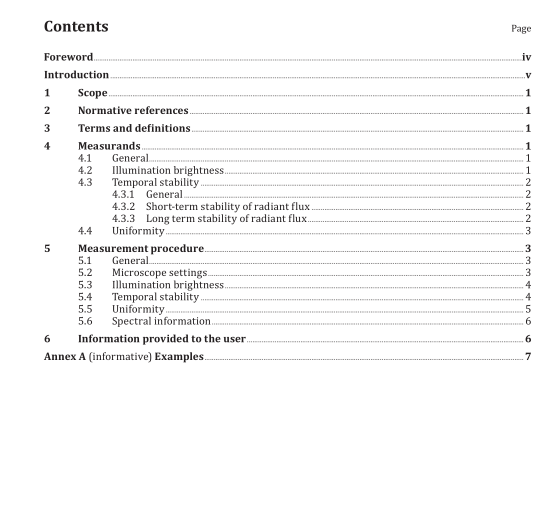ISO 19056-3:2022 pdf download.Microscopes — Definition and measurement of illumination properties — Part 3: Incident light fluorescence microscopy with incoherent light sources
5.4 Temporal stability
The measurement is performed with a 10× objective and a power meter placed so that the detection area of the power meter is underfilled with light. The detection range of the power meter shall be in the linear range. If a 10× objective is not available, the measurement shall be performed without an objective and the power meter shall be placed at the position of the pupil of the illumination, thus the objective needs to be removed. The power meter shall be mounted in a fixed position with regard to the objective or the objective nosepiece respectively. External influences on the measurement, e.g. changes in room temperature or changes in the ambient lighting conditions, have to be eliminated.
Figure 2 shows an alternative position of the power meter when used without objective. The detector of the power meter shall not be saturated. The integration time of the power meter shall be between 0,2 s and 1 s.
5.5 Uniformity
The measurement for uniformity shall be performed by using an electronic image sensor that can capture the specified image field. This electronic image sensor shall consist of at least 50 rows and columns of individual elements (pixels). Furthermore, the image sensor shall be designed for an entrance pupil at infinity.
If the mechanical design of the microscope does not allow the image sensor to be placed in the plane of the image field, no auxiliary optics that would be part of the measurement setup shall be used. In this case an uniformity value cannot be measured according to this document. This image sensor does not need to be calibrated in radiometric units as its output can be related to the brightness measurement described in 4.2. However, gamma correction shall not be applied to the signal from the image sensor in order to retain a linear relationship between irradiance and sensor signal (hence γ = 1).
The specimen shall be a homogeneous fluorescent specimen, e.g. a solution of a fluorescent marker or a broadband fluorescent polymer slide. Solutions of markers are generally preferable over solid samples, since bleached fluorophores in the object field are replaced by unbleached fluorophores due to diffusion.
While performing the measurement, it shall be ensured that the complete data recorded originates from the homogeneous fluorescent region of the specimen to avoid misjudgement, which might be caused, e.g. by field of curvature of the optics or a tilted specimen. The signal-to-noise ratio shall be sufficient to clearly determine the uniformity. The signal-to-noise ratio is considered sufficient if the uniformity varies less than 5 percentage points when the illumination brightness is increased by a factor of at least 1,5.
Table 1 shows examples for measurements, where signal-to-noise ratio is sufficient for determination of uniformity.
5.6 Spectral information
The illumination brightness and uniformity shall be referred to a specific spectral range. The spectral range shall be given as the wavelength of maximum brightness together with the two wavelengths at which the brightness is 50 % of the maximum value. If the brightness value of 50 % is achieved for more than two wavelengths, all spectral ranges shall be indicated. This spectral information can be measured in the focus plane of the objective or it can be calculated from theoretical values of the individual components (light source, filters, transmission of optical components). Examples are given in Annex A.
6 Information provided to the user
If information on illumination properties is provided to the user, information on illumination brightness and uniformity are mandatory; information on temporal stability is optional. Information shall be given according to the definitions given in 4.2, 4.3 and 4.4 and shall contain the following additional data:
a) information on the dimensions and shape of the image field;
b) information on the microscope configuration, especially additional optical elements (like filters,objective lens, etc.) that can be exchanged by the user but were part of the light train when measuring the illumination brightness.ISO 19056-3 pdf download.ISO 19056-3:2022 pdf download
